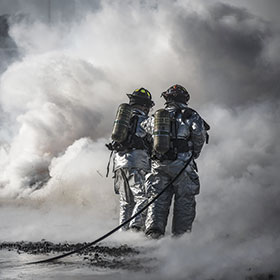

Automatic fire detection and suppression systems are installed to protect the occupants and property in all types of buildings and structures. These systems gain maximum benefit if alarm signals are transmitted automatically to alert the fire brigade or an ARC – alarm receiving centre/monitoring centre. A quick response to an actual fire alarm can assist in the saving of lives and lessening the extent of damage to property.
The automatic alerting of the monitoring centre of a potential emergency is of the utmost importance to assist in dealing timeously and successfully with an emergency, irrespective of whether premises are manned 24/7 or not. Automatic transmission of an alarm signal to the monitoring centre does not only assist in a quicker response being initiated, but can also give the responders pertinent details of the specific premises from which the alarm originated.
The information pertaining to the premises will assist the responders in dealing with the emergency. Typically, the database at the monitoring centre should contain relevant information about, for example, the site name; physical address; contact names and numbers of responsible persons, location of fire hydrants; flammable stores; etc. This empowers a ‘knowledge-based’ response to be initiated.
As per SANS 10139 Part 8.8.2(b), the primary means of alerting the fire service is for the occupants to make a call to the fire department. However, in an emergency, occupants may panic and forget to alert the monitoring centre timeously, which makes automatic transmission a critical feature, especially for high rise buildings or premises with a high-density occupancy. The transmission system should form part of the building safety plan.
Often, where SMS communicators are used to inform responsible staff (and not emergency services), the reaction time may be unsuitable to adequately attend to a fire situation. It is critical to ensure one has a suitable response plan for a real fire situation.
Methods of transmitting fire alarms to the monitoring centre are numerous. These include a normal telephone line, which is not ideal in South Africa due to cable theft, lightning, etc., mobile/cellular/GSM, one-way radio and two-way radio systems. A system that offers two-way speech is the preferred method, in order to allow voice communication between the protected premises and the monitoring centre.
In addition to the automatic transmission of fire alarms to the monitoring centre, other information such as fire panel faults, can also be relayed to enable quick action to be taken to resolve the problem and ensure the on-going integrity of the installation. False alarms must be eliminated as far as possible to prevent unnecessary responses by the fire service and/or evacuation of the protected premises.
The designer of the fire alarm system, after doing a risk assessment, will advise the user if an automatic transmission is required to the fire department or an alarm receiving centre. The designer will then refer to SANS 10139:2012 Part 8.8 on the guidelines to follow. An important point to note, mentioned in the standards, is that Category P systems should have an automatic transmission of fire signals to an alarm receiving centre, unless the premises is continuously occupied and the power requirements for automatic transmitting equipment should comply with SANS 10139 Part 8.18
We continue to encourage all end users and consultants to only use FDIA registered contractors as they have the commitment, capability and mandate to ensure that not only is your fire detection system installed correctly but it is serviced and maintained as per the required standards and regulations.
For comments and enquiries please contact the FDIA on [email protected]
| Email: | [email protected] |
| www: | www.fdia.co.za |
| Articles: | More information and articles about FDIA (Fire Detection Industry Association) |
© Technews Publishing (Pty) Ltd. | All Rights Reserved.